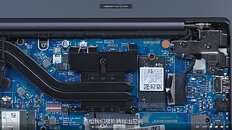Monday, January 25th 2021
Kosin Demonstrates RTX 3090 Running Via Ryzen Laptop's M.2 Slot
Kosin a Chinese subsidiary of Lenovo has recently published a video showing how they modded their Ryzen notebook to run an RTX 3090 from the NVMe M.2 slot. Kosin used their Xiaoxin Air 14 laptop with a Ryzen 5 4600U processor for the demonstration. The systems internal M.2 NVMe SSD was removed and an M.2 to PCIe expansion cable was attached allowing them to connect the RTX 3090. Finally, the laptop housing was modified to allow the PCIe cable to exit the chassis and a desktop power supply was attached to the RTX 3090 for power.
The system booted and correctly detected and utilized the attached RTX 3090. The system performed admirably scoring 14,008 points in 3DMark TimeSpy, for comparison the RTX 3090 paired with a desktop Ryzen 5 3600 scores 15,552, and when paired with a Ryzen 7 5800X scores 17,935. While this is an extreme example pairing an RTX 3090 with a mid-range mobile processor it goes to show the amount of performance achievable over the NVMe M.2 connector. The x4 PCIe 3.0 link of the laptop's M.2 slot could handle a maximum of 4 GB/s, while the x16 PCIe 3.0 slot on previous generation processors offered 16 GB/s, and the new x16 PCIe 4.0 connector doubles that providing 32 GB/s of available bandwidth.
Source:
PC Watch
The system booted and correctly detected and utilized the attached RTX 3090. The system performed admirably scoring 14,008 points in 3DMark TimeSpy, for comparison the RTX 3090 paired with a desktop Ryzen 5 3600 scores 15,552, and when paired with a Ryzen 7 5800X scores 17,935. While this is an extreme example pairing an RTX 3090 with a mid-range mobile processor it goes to show the amount of performance achievable over the NVMe M.2 connector. The x4 PCIe 3.0 link of the laptop's M.2 slot could handle a maximum of 4 GB/s, while the x16 PCIe 3.0 slot on previous generation processors offered 16 GB/s, and the new x16 PCIe 4.0 connector doubles that providing 32 GB/s of available bandwidth.




55 Comments on Kosin Demonstrates RTX 3090 Running Via Ryzen Laptop's M.2 Slot
Let us screw in an NVME in an enclosure, or, alternate devices that fit the connector (NVME cards, wifi cards, external GPU connector)
This video came out in 2014.
Edit: This has been done a lot in the M-STX world, where people use the x4 M.2 slot for external GPUs.
Let's pretend 6900XT doesn't beat 3090 in newest games, shall we...
Bandwidth doesn't tell the whole story.
One of my favorites was ADT Link, they had various mod you can imagine.
We may be about to see a trend of external GPU enclosures utilisng M.2 NVME slots, no longer needing fancy proprietary stuff
my excitement is simple: for decades i've wanted laptops to have a universal way to upgrade GPU's, and this may end up being it.